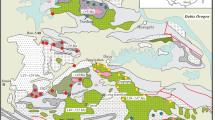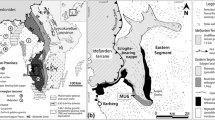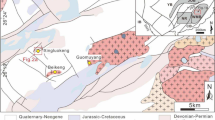Abstract
Titanium and zirconium analyses of quartz and rutile from blueschist samples from the eclogite–blueschist unit (EBU) in northern Sifnos, Greece, have been evaluated to determine the extent to which the intersection of the Ti-in-quartz (TitaniQ) and zirconium-in-rutile (ZiR) thermometers reflect peak metamorphic P–T conditions. Ti concentrations range from 100 to 530 ppb and Zr concentrations range from 14 to 44 ppm; there is no significant zoning observed in any grains and no significant differences in concentrations in samples south and north of the Vroulidia shear zone (VSZ). Lines of equal Keq from the TitaniQ and ZiR thermometers intersect at around 450–500 °C and 2.2–2.4 GPa, which is similar to the peak metamorphic conditions of 530 °C, 1.9 GPa for samples north of the VSZ. However, the intersection is inconsistent with the peak metamorphic conditions of 525 °C, 1.1–1.4 GPa for samples south of the VSZ even when TitaniQ temperatures are corrected for reduced activity of TiO2. Rather, TitaniQ temperatures are consistent with Ti values being incorporated into quartz during prograde metamorphism along a subduction geotherm of 10–12 deg/km at around 300 °C. ZiR temperatures are consistent with rutile nucleation and growth at around 450–500 °C along a similar metamorphic geotherm after the rutile-in reaction was overstepped by around 1 kJ/mol-O. The TitaniQ and ZiR thermometers do not, therefore, reflect peak metamorphic P–T conditions in these rocks but rather record recrystallization or growth processes during prograde subduction.






Similar content being viewed by others
Data availability statement
All data generated or analysed during this study are included in this published article (and its supplementary information files).
References
Angel RJ, Murri M, Mihailova B, Alvaro M (2019) Stress, strain, and Raman shifts. Zeitschrift für Kristallographie-Crystalline Materials 234:129–140
Ashley KT, Webb LE, Spear FS, Thomas JB (2013) P-T-D histories from quartz: a case study of the application of the TitaniQ thermobarometer to progressive fabric development in metapelites. Geochem Geophys Geosyst 14(9):3821–3843. https://doi.org/10.1002/ggge.20237
Bestmann M, Pennacchioni G (2015) Ti distribution in quartz across a heterogeneous shear zone within a granodiorite: the effect of deformation mechanism on Ti resetting. Lithos 227:37–56
Castro AE, Spear FS (2017) Reaction overstepping and reevaluation of the peak P-T conditions of the blueschist unit Sifnos, Greece: implications for the Cyclades subduction zone. Int Geol Rev 59:548–562
Cherniak DJ, Manchester J, Watson EB (2007a) Zr and Hf diffusion in rutile. Earth Planet Sci Lett 261:267–279
Cherniak DJ, Watson EB, Wark DA (2007b) Ti diffusion in quartz. Chem Geol 236:65–74
Grujic D, Stipp M, Wooden JL (2011) Thermometry of quartz mylonites: importance of dynamic recrystallization on Ti-in-quartz reequilibration. Geochem Geophys Geosyst 12:19
Guiraud M, Powell R (2006) P–V–T relationships and mineral equilibria in inclusions in minerals: Earth and Planetary Science Letters 244(3-4):683–694
Holland TJB, Powell R (1998) An internally-consistent thermodynamic dataset for phases of petrological interest. J Metamorph Geol 16:309–343
Holland TJB, Powell R (2011) An improved and extended internally consistent thermodynamic dataset for phases of petrological interest, involving a new equation of state for solids. J Metamorph Geol 29:333–383
Kohn MJ, Northrup CJ (2009) Taking mylonites’ temperatures. Geology 37(1):47–50. https://doi.org/10.1130/g25081a.1
Kohn MJ, Penniston-Dorland SC, Ferreira JCS (2016) Implications of near-rim compositional zoning in rutile for geothermometry, geospeedometry, and trace element equilibration. Contributions Mineral Petrol 171:15
Mazzucchelli ML, Angel RJ, Alvaro M (2021) EntraPT: an online platform for elastic geothermobarometry. Am Miner 106:830–837
Murri M, Mazzucchelli ML, Campomenosi N, Korsakov AV, Prencipe M, Mihailova BD, Scambelluri M, Angel RJ, Alvaro M (2018) Raman elastic geobarometry for anisotropic mineral inclusions. Am Miner 103:1869–1872
Nachlas WO, Hirth G (2015) Experimental constraints on the role of dynamic recrystallization on resetting the Ti-in-quartz thermobarometer. J Geophys Res 120:8120–8137
Nachlas WO, Whitney DL, Teyssier C, Bagley B, Mulch A (2014) Titanium concentration in quartz as a record of multiple deformation mechanisms in an extensional shear zone. Geochem Geophys Geosyst (G3) 15:1374–1397
Nachlas WO, Thomas JB, Hirth G (2018) TitaniQ deformed: experimental deformation of out-of-equilibrium quartz porphyroclasts. J Struct Geol 116:207–222
Osborne ZR, Thomas JB, Nachlas WO, Angel RJ, Hoff CM, Watson EB (2022) TitaniQ revisited: expanded and improved Ti-in-quartz solubility model for thermobarometry. Contributions Mineral Petrol 177:21
Pattison DRM, de Capitani C, Gaidies F (2011) Petrological consequences of variations in metamorphic reaction affinity. J Metamorph Geol 29(9):953–977. https://doi.org/10.1111/j.1525-1314.2011.00950.x
Roche V, Laurent V, Cardello GL, Jolivet L, Scaillet S (2016) Anatomy of the Cycladic Blueschist Unit on Sifnos Island (Cyclades, Greece). J Geodyn 97:62–87
Schmidt C, Ziemann MA (2000) In-situ Raman spectroscopy of quartz: a pressure sensor for hydrothermal diamond-anvil cell experiments at elevated temperatures. Am Miner 85(11–12):1725–1734
Spear FS, Pyle JM (2010) Theoretical modeling of monazite growth in a low-Ca metapelite. Chem Geol 273(1–2):111–119. https://doi.org/10.1016/j.chemgeo.2010.02.016
Spear FS, Wark DA (2009) Cathodoluminescence imaging and titanium thermometry in metamorphic quartz. J Metamorph Geol 27:187–205
Spear FS, Wolfe OM (2022) Nucleation theory applied to the development of contrasting garnet crystal densities. Contributions to Mineral Petrol 177:17
Spear FS, Wark DA, Cheney JT, Schumacher JC, Watson EB (2006) Zr-in-Rutile Thermometry in Blueschists from Sifnos, Greece. Contributions Mineral Petrol 152:375–385
Spear FS, Thomas JB, Hallett BW (2014) Overstepping the garnet isograd: a comparison of QuiG barometry and thermodynamic modeling. Contrib Miner Petrol 168(3):1–15. https://doi.org/10.1007/s00410-014-1059-6
Thomas JB, Spear FS (2018) Experimental study of quartz inclusions in garnet at pressures up to 3.0 GPa: evaluating validity of the quartz-in-garnet inclusion elastic thermobarometer. Contributions Mineral Petrol 173:14
Thomas JB, Watson EB, Spear FS, Shemella PT, Nayak SK, Lanzirotti A (2010) TitaniQ under pressure: the effect of pressure and temperature on Ti-in-quartz solubility. Contrib Miner Petrol 160:743–759
Tomkins HS, Powell R, Ellis DJ (2007) The pressure dependence of the zirconium-in-rutile thermometer. J Metamorph Geol 25:703–713
Wolfe OM, Spear FS (2018) Determining the amount of overstepping required to nucleate garnet during barrovian regional metamorphism, Connecticut Valley Synclinorium. J Metamorph Geol 36:79–94
Acknowledgements
This work has been supported by grants from the National Science Foundation 1447468 and 1750674 (to Spear) and the Edward P. Hamilton Distinguished Professor Chair (Rensselaer). Insightful reviews by Z. Osborne and two anonymous reviewers greatly improved the presentation of the manuscript.
Author information
Authors and Affiliations
Corresponding author
Additional information
Communicated by Mark S Ghiorso.
Publisher's Note
Springer Nature remains neutral with regard to jurisdictional claims in published maps and institutional affiliations.
Supplementary Information
Below is the link to the electronic supplementary material.
Rights and permissions
Springer Nature or its licensor (e.g. a society or other partner) holds exclusive rights to this article under a publishing agreement with the author(s) or other rightsholder(s); author self-archiving of the accepted manuscript version of this article is solely governed by the terms of such publishing agreement and applicable law.
About this article
Cite this article
Spear, F.S., Wolfe, O.M. & Cheney, J.T. On the interpretation of TitaniQ and ZiR thermobarometry in subduction complexes. Contrib Mineral Petrol 178, 8 (2023). https://doi.org/10.1007/s00410-022-01989-4
Received:
Accepted:
Published:
DOI: https://doi.org/10.1007/s00410-022-01989-4




